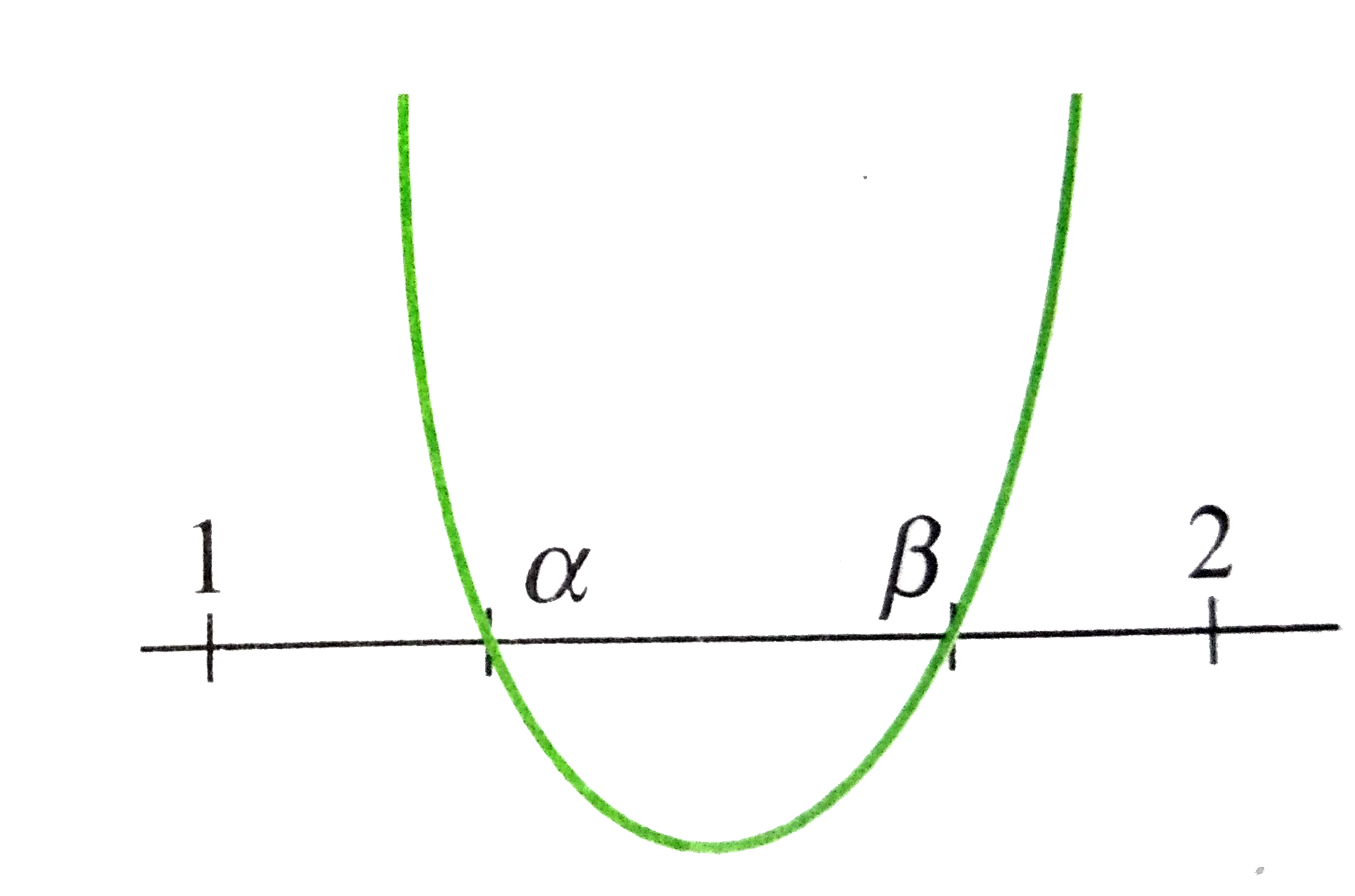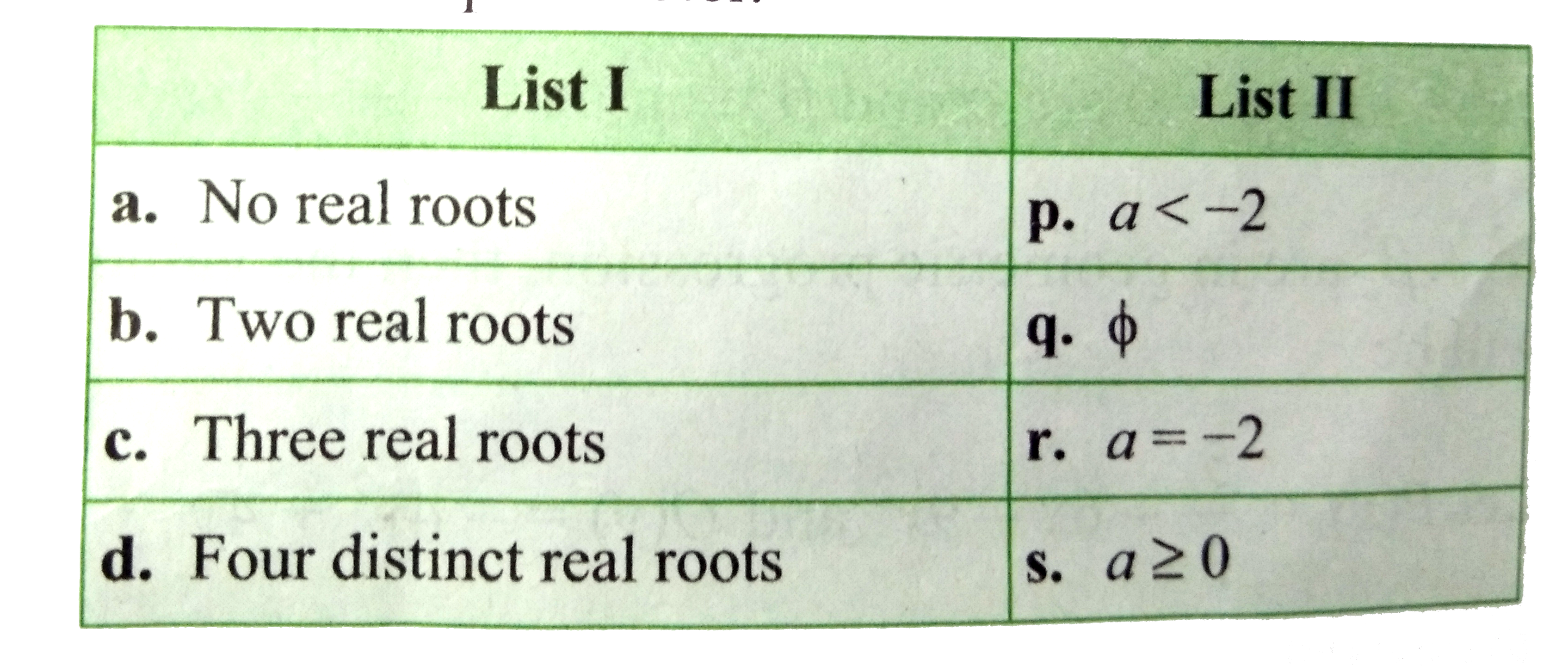Consider the quadrationax2−bx+c=0,a,b,c∈N which has two distinct real roots belonging to the interval (1,2).
The least value of b is Solution in Bengali
4
6
7
5
The correct Answer is:2
az2−bx+c=0
Let f(x)=ax2−bx+cbe
the correspoding quadratic expression and α,β be the roots of f(x)=0.

Then, f(x)=a(x−α)(x−β)
Now, af(1)>0,af(2)>0,1<b2a<2,b2−4ac>0
⇒a(1−α)(1−β)>0,a(2−α)(2−β)>0,2a<b<4a,b2−4ax>0
⇒a2(1−α)(1−β)(2−α)(2−β)>0
⇒a2(1−α)(1−β)(2−α)(2−β)>0
As f(x) and f(2) both are integers and f(1)>0, and f(2)>0, so
f(1)f(2)>0
⇒f(1)f(2)>1
⇒1≥a2(α−1)(2−α)(β−1)(2−β) (1)
Now, (α−1)+(2−α)2>((α−1)(2−α))1/2
⇒(α−1)(2−α)≤14
Similarly,
(β−1)(2−β)≤14
⇒(α−1)(2−α)(β−1)(2−β)<116
As α≠β, so α2>1 (Using (1))
⇒a>5
⇒b2>20candb>10⇒b≥11
Also, b2>100⇒c>5⇒c≥6
Topper's Solved these Questions
- BOOK - CENGAGE PUBLICATIONCHAPTER - THEORY OF EQUATIONSEXERCISE - MATRIX MATCH TYPE6videos
THEORY OF EQUATIONS
- BOOK - CENGAGE PUBLICATIONCHAPTER - THEORY OF EQUATIONSEXERCISE - NUMERICAL VALUE TYPE43videos
THEORY OF EQUATIONS
- BOOK - CENGAGE PUBLICATIONCHAPTER - THEORY OF EQUATIONSEXERCISE - Multiple Correct Answer Type38videos
THEORY OF EQUATIONS
- BOOK - CENGAGE PUBLICATIONCHAPTER - STRAIGHT LINESEXERCISE - ARCHIVES (NUMERICAL VALUE TYPE)1videos
STRAIGHT LINES
- BOOK - CENGAGE PUBLICATIONCHAPTER - THREE DIMENSIONAL GEOMETRYEXERCISE - All Questions291videos
THREE DIMENSIONAL GEOMETRY
Similar Questions
Match the following for the equation x2+a|x|+1=0 where, a is a parameter.
 10:00View Solution
10:00View SolutionIf x=2+22/3+21/3 , then the value of x3−6x2+6x is
02:22View SolutionIf c≠0 and the equation p2x=ax+c+bx−c has two equal roots, then p can be
04:56View SolutionFor a point P in the plane, let d1(P)andd2(P) be the distances of the point P from the lines x−y=0andx+y=0 respectively. The area of the region R consisting of all points P lying in the first quadrant of the plane and satisfying 2≤d1(P)+d2(P)≤4, is
View SolutionFind the angle between the line whose direction cosines are given by l+m+n=0andl2+m2−n2=0.
View SolutionIf ax2−bx+c=0 have two distinct roots lying in the interval (0,1);a,b,∈N, then the least value of a , is
View SolutionIf the equation ax^(2)+bx+c=0 has distinct real roots and ax^(2)+b{x}+C=0 also has two distinct real roots then
06:01View SolutionIf ax2+bx+c=0, a≠0, a, b, c∈R has distinct real roots in (1,2), then a and 5a+2b+c have
08:28View SolutionConsider the quadrationax2−bx+c=0,a,b,c∈N which has two distinct real roots belonging to the interval (1,2).
The least value of a is05:54View SolutionConsider the quadrationax2−bx+c=0,a,b,c∈N which has two distinct real roots belonging to the interval (1,2).
The least value of b is04:30View SolutionConsider the quadrationax2−bx+c=0,a,b,c∈N which has two distinct real roots belonging to the interval (1,2).
The least value of c is08:02View SolutionA quadratic equation ax2+bx+c=0has two distinct real roots, if….
05:23View SolutionConsider the quadrationax2−bx+c=0,a,b,c∈N which has two distinct real roots belonging to the interval (1,2).
The least value of b is05:18View SolutionIf a,b,c belong to R,a≠0, and the quadratic equation ax2+bx+c=0 has no real roots. Then , which one of the following is correct?
05:52View SolutionIf ax2−bx+c=0 have two distinct roots lying in the interval (0,1);a,b,∈N, then the least value of a , is
05:41View SolutionIfax2−bx+c=0 has two distinct roots lying in the interval (0,1),a,b,c∈N. Then
06:55View Solution

